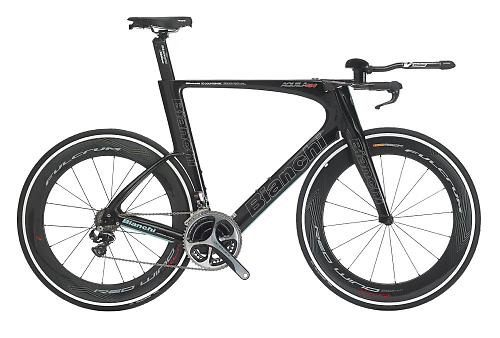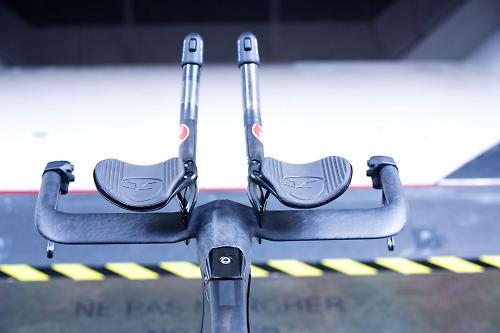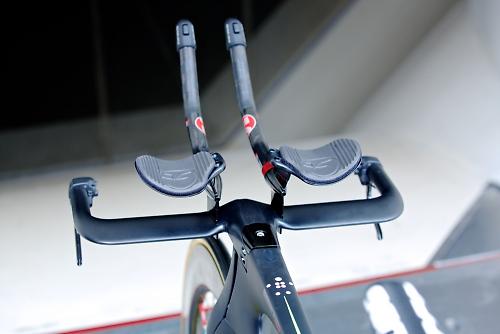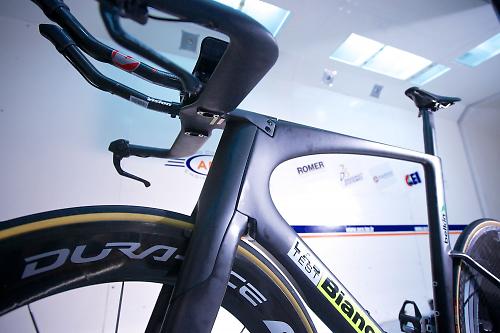- News
- Reviews
- Bikes
- Accessories
- Accessories - misc
- Computer mounts
- Bags
- Bar ends
- Bike bags & cases
- Bottle cages
- Bottles
- Cameras
- Car racks
- Child seats
- Computers
- Glasses
- GPS units
- Helmets
- Lights - front
- Lights - rear
- Lights - sets
- Locks
- Mirrors
- Mudguards
- Racks
- Pumps & CO2 inflators
- Puncture kits
- Reflectives
- Smart watches
- Stands and racks
- Trailers
- Clothing
- Components
- Bar tape & grips
- Bottom brackets
- Brake & gear cables
- Brake & STI levers
- Brake pads & spares
- Brakes
- Cassettes & freewheels
- Chains
- Chainsets & chainrings
- Derailleurs - front
- Derailleurs - rear
- Forks
- Gear levers & shifters
- Groupsets
- Handlebars & extensions
- Headsets
- Hubs
- Inner tubes
- Pedals
- Quick releases & skewers
- Saddles
- Seatposts
- Stems
- Wheels
- Tyres
- Health, fitness and nutrition
- Tools and workshop
- Miscellaneous
- Tubeless valves
- Buyers Guides
- Features
- Forum
- Recommends
- Podcast
TECH NEWS
Bianchi launch Aquila CV time trial bike
Bianchi are launching a new time trial bike, the Aquila CV, that uses Countervail vibration cancelling technology. The bike was raced for the first time on Saturday by Team Belkin’s Bauke Mollema and Laurens Ten Dam in the Tour de France’s Stage 20 time trial.

We’ll come back to the Countervail technology in a mo. Bianchi’s main goal here was to produce a bike with minimal drag. They’ve sought to do this by developing an aerodynamically efficient frame and fork and integrating the components; there are no exposed bolts/fasteners and very little exposed cabling to disturb the airflow.

The high-modulus carbon monocoque frame uses NACA (National Advisory Committee for Aeronautics) aerodynamic tube profiles. Many brands truncate the tube profiles – they effectively get rid of the long, tapering trailing edges and chop them off square instead, the idea being that you get virtually the same aero benefit with less material. Bianchi haven’t done this; they’ve kept the trailing edges in place.

Bianchi say that the Aquila CV has been designed using CFD (computational fluid dynamics) simulation software and pro athlete feedback, and developed and tested in the wind tunnel – which is the usual way of doing things these days.

They say that the front of the frame, fork and bars are the most important profiles when it comes to minimising drag because these are the first areas to encounter undisturbed air. For that reason, they focused their efforts in component design and aero integration here.
Bianchi have engineered a customised cover, made from carbon fibre, that sits in front of the head tube and front V-brake system.

The rear V-brake is positioned behind the bottom-bracket to minimise the aerodynamic drag.

Like the frame tubes, the Bianchi-designed handlebar/stem, made by FSA, is NACA airfoil shaped. It is 41cm wide and is integrated into the rest of the front-end design. All the cables run inside the handlebar so that they can’t disturb the airflow. The stem is available in three different lengths: 90mm 110mm and 130mm.

The Aquila CV comes with adjustable rear dropouts so you can fine tune the distance between the rear wheel and the seat tube to reduce turbulence, and it has a steep seat tube angle of 76.5° to help you get into an aerodynamically efficient ride position. The aluminium seatpost clamp comes with two different positions with +/- 18mm setback so you can get the setup you want.

The full carbon fork comes with a standard 1 1/8in steerer and straight, bladed legs.
Interestingly, Bianchi say that even the paint they’ve used is specifically designed to reduce drag. The surface of it is such that they can't use their normal graphics, they’ve had to get new ones made up.

What about the Countervail technology, then? Well, that’s something that Bianchi first introduced last year on the Infinito CV (which we made road.cc Bike of the Year). Bianchi collaborated with Materials Sciences Corporation to come up with a material that reduces road vibration. It’s all a bit Secret Squirrel but Bianchi have exclusive use of Countervail in the cycling industry.

“With the patented carbon fibre architecture and viscoelastic material, Countervail carbon material, embedded within the Aquila CV carbon frame and fork, immediately cancels vibration while increasing the stiffness and strength of the entire frame/fork system,” say Bianchi.
They list these benefits (these are Bianchi’s own words):
• Maximised ride control and handling, allowing the rider sustained best aero position in varied road conditions.
• Reduced muscle fatigue, in particular the neck, shoulders and lower back empowering leg strength and increasing overall duration.
• Increased energy savings, improve the rider’s overall performance.
• Increased rigidity and peak power output over long distances.
For statistic fans, Bianchi claim that the Countervail tech provides “75% increased vibration cancelling capacity”.

We’ve not ridden the Aquila but we were certainly massively impressed by the Infinito CV, so we’ll keep our fingers crossed that the Aquila is equally good.
The Aquila is compatible with both mechanical and electronic groupsets and is available in four sizes: XS, S, M and L. Bianchi give a frame weight of 1.3kg.

The bikes the pros use are never cheap, of course. The Aquila frameset – including the full-carbon fork, TRP TTV RCR brakes, the FSA Bianchi aero carbon stem/bar, and Bianchi’s aero carbon seatpost – is priced at £4,500.
The Aquila CV is available in two complete builds. If you go for the model with a Shimano Ultegra mechanical groupset and Fulcrum Racing Quattro clinchers, that’ll cost you £5,000.
The top-end model comes with a Shimano Dura-Ace Di2 groupset and Fulcrum Red Wind XLR 80mm-deep wheels. That one is priced at £8,900. The first ones will arrive in the UK later in the year, possibly in September.
Mat has been in cycling media since 1996, on titles including BikeRadar, Total Bike, Total Mountain Bike, What Mountain Bike and Mountain Biking UK, and he has been editor of 220 Triathlon and Cycling Plus. Mat has been road.cc technical editor for over a decade, testing bikes, fettling the latest kit, and trying out the most up-to-the-minute clothing. He has won his category in Ironman UK 70.3 and finished on the podium in both marathons he has run. Mat is a Cambridge graduate who did a post-grad in magazine journalism, and he is a winner of the Cycling Media Award for Specialist Online Writer. Now over 50, he's riding road and gravel bikes most days for fun and fitness rather than training for competitions.
Latest Comments
- ktache 7 hours 6 min ago
The people at Hexlox have asked me to tell others about their black Friday deals, but I don't quite know what the offer is yet. But saving anything...
- Freddy56 7 hours 16 min ago
Would love to know if anyone else thinks the army green winter jackets are actually better than black to hide the cyclist profile in low light?
- momove 7 hours 24 min ago
You two are going to have to help out the undereducated here!...
- VIPcyclist 7 hours 49 min ago
Whilst I was reading this I was thinking : sounds familiar, yep, that's right . Then I read the bit about being referred for a fitness to drive and...
- Dnnnnnn 8 hours 2 min ago
I'm unclear how simply considering the views of people who travel through an area is voting for rat-runs. No need to explain though.
- David9694 9 hours 1 min ago
When you don't know for sure what the whinge would be if this work was postponed to January, but you know there would be one:...
- biking59boomer 9 hours 42 min ago
Sadly the cyclist hate in this country seems to have worsened of late. Dangerous motoring combined with anti-cycling officialdom in some places is...
- Cyclo1964 12 hours 14 min ago
Brilliant 🤣













































Add new comment
10 comments
Bring it up north. Us lads will take it for a spin past to compos chippy in holmfirth. If it gets nicked its a decent bike. We only have posh thieves up here.
Once you take it up here, after a bag of chips and three pints of pale ale, you might as well be on a penny farthing. Complete waste of money. Money better spent on a cortina and three weeks in benidorm.
Stay happy, ride safe, sleep well and eat proper foods not those stupid gels and salt drinks.
That gives credence to UCI's fitting regs that force the riders to be in pain for the whole TT.
I thought non-structural fairings were illegal under UCI rules?
I think they changed the rules and they have to fit in a 'box' they have, as the Pinarello Bolide has similar covers
Not sure it helped Mollema and Ten Dam that much on Saturday, they seemed to really struggle, or is it that this is such a comfortable TT bike that they just relaxed and started to drift off? either way it goes to show that it's only as fast as the engine pushing it, judging by that, I think Tony Martin could have won on a boris bike the power he was pushing.
Can it be fitted with mudguards? A pannier would be a nice addition too.
In all seriousness, though, how much difference does all the aero tech make when you stick a human being on top, albeit one with a funny-shaped helmet?
Aerodynamics make a huge difference. If you add up the frame, wheels, handlebars, position, skinsuit, helmet, shoe covers etc. - quite literally the difference between winning and losing. So yes it matters.
http://cyclingtips.com.au/2010/04/biggest-bang-for-your-buck-in-time-tri...
Add it all up, yes that shows the rider based stuff makes a huge difference, but take away the aero bike and wheels and Tony Martin would have come 6th on Stage 20.
I can easily average 5kph higher on a TT bike compared to a round-tube road bike over a distance of 100 km. It feels like having a leadout train - all the time. But I prefer the road bike: safer on open roads, more comfortable, and one could hold a conversation out of the foetal position.
OK, that's a good answer. Despite the responses above, I do understand the concepts of aerodynamics, but no one's put it into context until now.